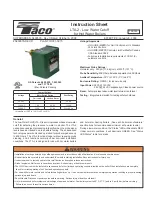
20
INS
TALLER
US
ER
MAINTEN
AN
CE TECHNI
CI
AN
2.4 USING THE BOILER.
Before ignition, make sure the heating system
is filled with water and that the manometer (7)
indicates a pressure of 1 ÷ 1.2 bar.
- Open the gas cock upstream from the boiler.
- Press the button (2) until the display switches
on, after which press the button in sequence
(2) and take the boiler to the summer (
)
or winter (
) position.
•
Summer
(
)
:
in this mode the boiler func-
tions only to heat the DHW, the temperature
is set via the buttons (3-4) and the relative
temperature is shown on the display via the
indicator (16).
• Winter
(
)
:
in this mode the boiler func-
tions both for heating domestic hot water and
heating the environment. The temperature of
the DHW is always regulated via buttons (3-4),
the heating temperature is regulated via buttons
(5-6) and the relative temperature is shown on
the display via the indicator (16).
From this moment the boiler functions auto-
matically. With no demand for heat (heating or
domestic hot water production) the boiler goes to
“standby” function, equivalent to the boiler being
powered without presence of flame. Each time
the burner ignites, the relative flame present sym-
bol is displayed (10) with relative power scale.
•
Operation with Comando Amico Remoto
V2
remote control (CAR
V2
) (Optional).
If the
CAR
V2
is connected, the (
) symbol will
appear on the display. The boiler regulation pa-
rameters can be set via the CAR
V2
control panel
and the reset button (1) remains active on the
boiler control panel, along with the switch-off
button (2) (“off” mode only) and the display
where the functioning state is shown.
Important:
if the boiler is put into “off” mode
on the CAR
V2
the “CON” connection error
symbol will appear on the CAR
V2
. The CAR
V2
is
however powered constantly so as not to loose
memorised programs.
•
Functioning with optional external probe
(
)
.
In the case of a system with optional
external probe, the boiler flow temperature for
room central heating is managed by the exter-
nal probe depending on the external tempera-
ture measured (Par. 1.6). The flow temperature
can be modified by selecting the functioning
curve via buttons (5 and 6), selecting a value
from “0 to 9” (Fig. 1-7).
With external probe present, the relative
symbol will appear on the display (12). In the
central heating phase, if the temperature of the
water contained in the plant is sufficient to heat
the radiators, the boiler can only function with
the activation of the boiler pump.
•
“Stand-by” mode.
Press button (2) in suc-
cession until the (
) symbol appears. The
boiler remains active from this moment and the
anti-freeze function, pump anti-block function
and 3-way and signalling of any anomalies is
guaranteed.
N.B.:
in these conditions the boiler is consid-
ered still live.
•
“Off” mode.
By holding the button (2) down
for 8 seconds, the display switches-off and the
boiler is off completely. The safety functions are
not guaranteed in this mode.
N.B.:
in these conditions the boiler is considered
still live even if there are no functions active.
•
Display functioning.
The display lights up
during the use of the control panel, after 15
seconds inactivity, the brightness drops until
just the active symbols are displayed. The light-
ing mode can be varied via parameter P2 in the
circuit board customisation menu.
2.5 TROUBLESHOOTING.
The boiler signals out anomalies by flashing on
the display and relative error codes, listed on the
table, are displayed.
Anomaly signalled
code
displayed
(flashing)
No ignition block
01
Safety thermostat block
(over-temperature), flame
control anomaly
02
Fan anomaly
03
General boiler board anomaly
04
Flow probe anomaly
05
Domestic hot water probe
anomaly
06
Maximum N° of reset
08
Insufficient system pressure
10
Flue pressure switch failure
11
Configuration error
15
Parasite flame
20
Push button control panel
anomaly
24
Insufficient circulation
27
Loss of remote control
communication
31
Low power supply voltage
37
Loss of flame signal
38
Block due to loss of
continuous flame signal
43
Ignition block.
The boiler ignites automati-
cally with each demand for room heating or hot
water production. If this does not occur within
10 seconds, the boiler goes into ignition block
(code 01). To eliminate “ignition block” the Reset
button (1) must be pressed. On commissioning
or after extended inactivity it may be necessary
to eliminate the “ignition block”. If this phe-
nomenon occurs frequently, contact a qualified
technician for assistance (e.g. Immergas After-
Sales Technical Assistance Service).
Overtemperature thermostat block.
During
normal functioning, if a fault causes excessive
overheating internally, the boiler goes into over-
temperature block (code 02). After allowing to
cool, eliminate the “overtemperature block” by
pressing the Reset key (1). If this phenomenon
occurs frequently, contact a qualified technician
for assistance (e.g. Immergas After-Sales Techni-
cal Assistance Service).
Fan anomaly.
This occurs if the fan is blocked
or if the intake or drain pipes are obstructed. If
normal conditions are restored the boiler restarts
without having to be reset. If this anomaly per-
sists, contact a qualified technician for assistance
(e.g. Immergas After-Sales Technical Assistance
Service).
General boiler board anomaly.
This takes place
if the boiler board microprocessor erroneously
recognises a signal (code 04). To eliminate
the “generic boiler board anomaly block”, it is
necessary to press the Reset button (1). If this
phenomenon occurs frequently, contact a qua-
lified technician for assistance (e.g. Immergas
After-Sales Technical Assistance Service).
Delivery probe anomaly.
If the board detects
an anomaly on the delivery probe (code 05), the
boiler will not start; contact a qualified technician
for assistance (e.g. Immergas After-Sales Techni-
cal Assistance Service).
Domestic hot water probe anomaly.
If the board
detects an anomaly on the domestic hot water
NTC probe, the boiler signals the anomaly. In this
case the boiler continues to produce domestic
hot water but not with optimal performance.
Moreover, the anti-freeze function is prevented
and an authorised technician must be called (e.g.
Immergas After-Sales Service).
Maximum N° of reset.
To eliminate any
“anomaly” the Reset button (1) must be pressed.
The Anomaly can be reset 5 times consecutively,
after which the function in inhibited for at least
one hour. One attempt is gained every hour for
a maximum of 5 attempts.
Insufficient system pressure.
Water pressure
inside the heating system (code 10), sufficient to
guarantee the correct functioning of the boiler,
is not detected. Check that the system pressure
is between 1÷1.2 bar.
Fumes pressure switch failure.
It occurs in the
case of an error on the circuit board that gives
consent for fan start-up incorrectly or in the
case of flue-gas pressure switch fault (code 11).
If normal conditions are restored the boiler re-
starts without having to be reset. If this anomaly
persists, contact a qualified technician for as-
sistance (e.g. Immergas After-Sales Technical
Assistance Service).
Configuration error.
If the board detects an
anomaly or incongruency on the electric wiring,
the boiler will not start. If normal conditions are
restored the boiler restarts without having to be
reset. If this anomaly persists, contact a qualified
technician for assistance (e.g. Immergas After-
Sales Technical Assistance Service).
Parasite flame.
This occurs in case of a leak on
the detection circuit or anomaly in the flame
control unit. (code 20), try to reset the boiler.
If the anomaly continues contact a qualified
technician (e.g. Immergas After-Sales Technical
Assistance Service).
Push button control panel anomaly.
This occurs
when the circuit board detects an anomaly on the
push button control panel. If normal conditions
are restored the boiler restarts without having
to be reset. If this anomaly persists, contact a
qualified technician for assistance (e.g. Immergas
After-Sales Technical Assistance Service).
Insufficient circulation.
This occurs if the boiler
overheats due to insufficient water circulating in
the primary circuit (code 27); the causes can be:
- low circulation; check that no interception
devices are closed on the central heating circuit
and that the system is free of air (deaerated);
- pump blocked; free the pump.
If this phenomenon occurs frequently, contact a
qualified technician for assistance (e.g. Immergas
After-Sales Technical Assistance Service).
Summary of Contents for MINI EOLO 28 3E
Page 1: ...MINI EOLO 28 3E Instruction and warning booklet IE 1 038767ENG ...
Page 2: ......
Page 28: ...28 3 5 4 4 5 6 6 d d c INSTALLER USER MAINTENANCE TECHNICIAN ...
Page 32: ...32 ...
Page 33: ...33 ...
Page 34: ...34 ...
Page 35: ...35 ...
















































